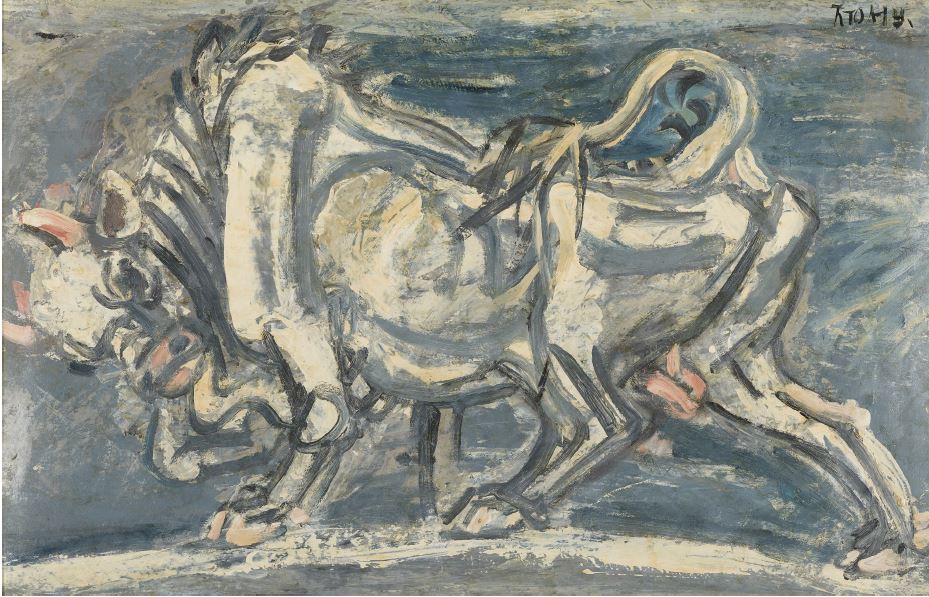| |
 |
|
| ▲ White Ox, 34.2x53.0 1953-54 |
Lee Jung-seob (1916–1956)'s name is one of the most frequently discussed in modern Korean art. While "White Ox (Picture 1)," a painting completed in his later years, is often considered his magnum opus, the ox was the subject of painting throughout his life.
Spending his childhood in Pyongyang, he entered Osan School in Jeongju, Pyeonganbuk-do and trained in art with Im Yong-ryeon (1901–?), a western-style painter. For his active involvement in the March 1 Movement, Im had been wanted by the Japanese police. He may have had a formative influence on Lee's artistry. In fact, Lee's submission to an exhibition in Japan was a painting of an ox. At the time, the ox was something that reminded the Japanese of Korea, an animal that represented the sentiment of Korean people. Lee Jung-seob's ox must have meant more than just an animal.
In this picture, Lee's signature is "Dung-seob" instead of "Jung-seob." He did this in anger at a pro-Japanese Joseon writer who turned his coat and wrote a column in Maeil Sinbo, urging Koreans to shave their heads like the monks ("jung") and join the war effort. Because the word "monk" has the same sound as the first syllable of his name, he was ashamed to write his actual name on the painting.
| |
 |
|
| ▲ Lee Jung-seob at an exhibition held in Tongyeong’s Hosim Cafe in March, 1954 |
In 1945, he married a Japanese woman Lee Namdeok (née Yamamoto Masako).When the Korean War began in 1950, he moved to South Korea. He first arrived in Jeju in 1951 as he fled the war to Seogwipo. Off the Seogwipo coast are three uninhabited islands, Beomseom, Munseom, and Seopseom. The three are all part of the UNESCO Bio Reserves in Jeju.
Of the three, Seopseom is known as Lee Jung-seob's island. Before Seogwipo Port was developed, he could see Seopseom from his home. Lee Jung-seob endured the destitution as a war refugee painting the island. A resident named Hyun Chi-su helped him get a small room with a kitchen, where he lived with his wife and two sons. This was the one and only time that Lee lived with his family, before sending them to Japan.
| |
 |
|
| ▲ A View of Seopseom, 41x71, 1951 |
The room, about 4.6 square meters, is always open. If you take a step inside through the narrow kitchen, you will find a frame with Lee's photo. Here, he created paintings like "Fantasy of Seogwipo" and "A View of Seopseom" (Picture 2). Climb up to the roof of Lee Jung-seob Gallery and you can see view similar to that of the painting "A View of Seopseom."
As Lee suffered from severe poverty, he didn't have enough money to buy art materials and resorted to drawing on the silver foil of cigarette boxes. The silver foil series represent his impoverished, yet passionate soul for art. The drawings remind you of the ancient Buddhist inscriptions on the boulders of Gyeongju. The silver foil drawings are owned by the top international art museum, the Museum of Modern Art (MoMA) in New York. The collectors are trading his artworks at high prices in art auctions. They amount to sums of money the artist himself could never touch in his life.
| |
 |
|
| ▲ Family in Paradise(Silver foil)8.3x15.4, 1950s, courtesy of MoMA |
The dire situation of poverty forced his wife to go to Japan with their two sons. Lee could meet his family only once thereafter. Gathering some money working as a port worker, he used the crewmember ID to visit his wife's family in Japan. Dreaming of the reunion with his family, he drew them riding a cart on a piece of silver foil. There is a painting that has the same composition as this illustration. It's the oil painting "Family on the Road" (1954, Picture 5). This painting has the two major themes of his life, family and the ox. It's reflects his wish for a utopia without the cold, hunger, tears, and sorrow. Reminding us of poet Gu Sang's remarks about Lee, "I know no other artist more in accord with his painting, self, and art," it almost serves as an autobiographical painting.
| |
 |
|
| ▲ Family on the Road , 29.5x64, 1954 |
In 1955, thanks to his friends' support, Lee held his first and last exhibition at Myeong-dong's Midopa Department Store (today's Lotte Young Plaza). The exhibition in Seoul was a success, with more than 40 paintings displayed and 20 sold. But because of the poor financial situations of the buyers, they would substitute the money with food or forgo payment after long delays. In the end, Lee was left with meager amount that barely supported his effort.
As a result, he could only afford to buy food and drinks for the friends who helped his exhibition. Lee fell into despair, ashamed that he could not support his family as a breadwinner. This led him to suffer from anorexia and schizophrenia. In 1956, he passed away from hepatitis at Seodaemun Redcross Hospital in Seoul. He was 41. It was too late when his friends found out; his corpse and overdue hospital bills were all that remained.
| |
 |
|
| ▲ Artist drawing his family / Drawing in the letter to his son, 1953 |
|

























